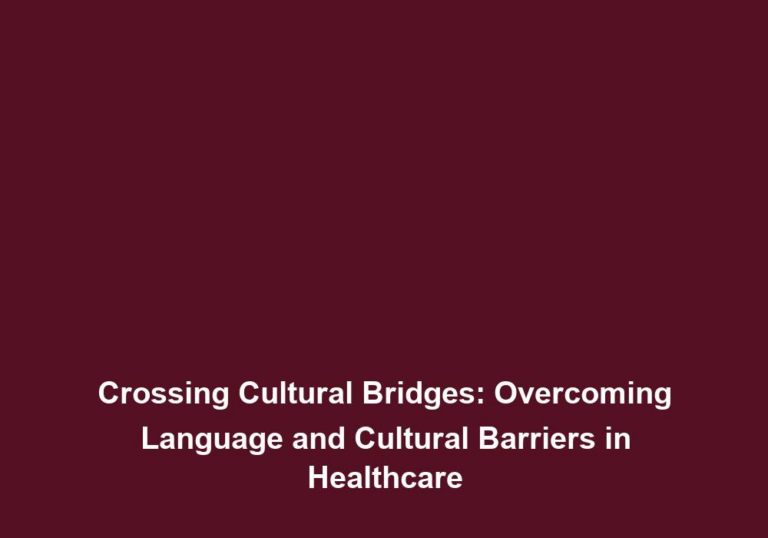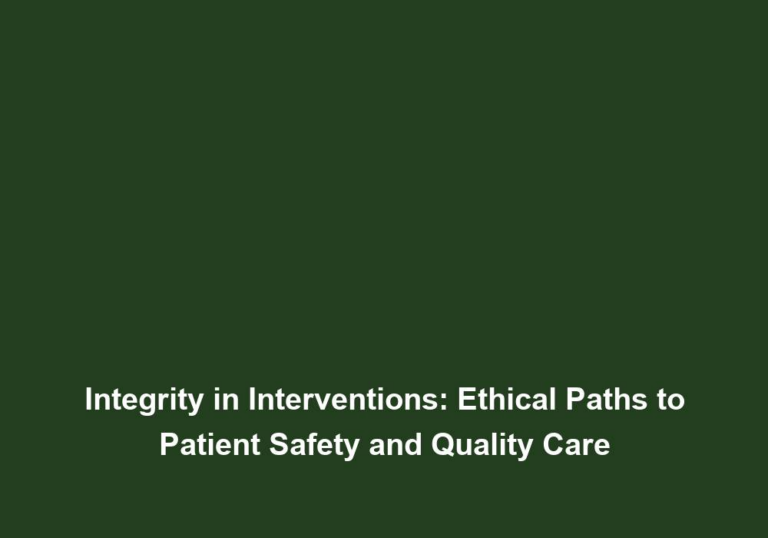Healing Across Cultures: Embracing Cultural Competence in Clinical Practice
As healthcare professionals, it is crucial to recognize and embrace the importance of cultural competence in clinical practice. With our diverse patient population, cultural competence plays a vital role in providing effective care, promoting healing, and ensuring patient satisfaction. By understanding and appreciating different cultural beliefs, values, and practices, we can foster trust, improve communication, and enhance health outcomes for our patients.
The Significance of Cultural Competence
Cultural competence refers to the ability of healthcare providers to understand and appreciate the cultural backgrounds of their patients. It involves acquiring knowledge, attitudes, and skills necessary to deliver culturally sensitive care. By being culturally competent, healthcare providers can effectively navigate the complexities of diverse cultural practices and beliefs, facilitating effective communication and personalized care.
Cultural competence is significant because it:
- Enhances patient-provider relationships: When healthcare providers demonstrate cultural competence, patients feel understood and respected, which promotes trust and effective communication. This, in turn, leads to better clinical outcomes.
- Reduces health disparities: Cultural competence allows healthcare providers to address the unique needs and perspectives of diverse patient populations. By tailoring care to patients’ cultural beliefs and practices, healthcare providers can minimize health disparities and improve health outcomes.
- Increases patient satisfaction: When patients receive care that is sensitive to their cultural backgrounds, they are more likely to be satisfied with their healthcare experience. This can contribute to greater patient loyalty and positive word-of-mouth referrals.
Enhancing Patient Trust and Communication
Building trust and effective communication with patients is essential for successful clinical outcomes. By demonstrating cultural competence, healthcare providers can break down barriers and establish a strong rapport with their patients. Patients are more likely to open up and share relevant information about their health when they feel understood and respected.
To promote trust and effective communication, healthcare providers should:
- Be open-minded: Embrace diversity and be willing to learn about different cultures. Avoid making assumptions or stereotypes based on cultural backgrounds. Recognize that cultural competence is an ongoing process of self-reflection and learning.
- Active listening: Pay attention to verbal and non-verbal cues, allowing patients to share their experiences and concerns without interruption. This helps in understanding their unique needs and perspectives. Practice empathy and validate patients’ feelings and experiences.
- Language services: Utilize professional interpreters or translators when needed to ensure accurate communication with patients who do not speak English fluently. This helps in overcoming language barriers and ensures clear and effective communication.
- Non-judgmental attitude: Avoid judgment or criticism of cultural practices that may differ from one’s own. Show respect and empathy towards patients’ cultural beliefs and values. This helps in creating a safe and inclusive environment for patients to express themselves.
Tailoring Treatment Plans
Cultural competence enables healthcare providers to tailor treatment plans that are compatible with each patient’s cultural beliefs, practices, and values. By acknowledging and incorporating culturally appropriate approaches, we can enhance patient engagement, adherence to treatment, and overall health outcomes.
Consider the following strategies when developing treatment plans:
- Cultural beliefs and practices: Take into account the cultural beliefs and practices that may influence patients’ health decisions. Respectfully acknowledge and discuss these factors to develop mutually agreed-upon treatment goals. For example, in some cultures, certain foods or activities may be considered beneficial for healing.
- Health literacy and education: Deliver health information in a culturally sensitive manner, using language and concepts that are easily understandable and relatable to the patient’s cultural background. Consider using visual aids, culturally appropriate metaphors, and storytelling techniques to enhance understanding.
- Holistic approach: Embrace holistic approaches that align with cultural beliefs, such as traditional healing practices or herbal remedies, when appropriate and safe. Collaborate with patients to integrate these practices into their treatment plans, ensuring a comprehensive and patient-centered approach.
- Inclusion of family and community: Recognize the importance of involving family members or community leaders in decision-making processes, as they often play a significant role in healthcare decisions within certain cultures. Engage with patients’ support systems to gain a better understanding of their cultural context and ensure a collaborative approach to care.
Overcoming Language and Communication Barriers
Effective communication is a cornerstone of providing quality care. Language and communication barriers can significantly impact patient-provider interactions and contribute to misunderstandings or misdiagnoses. Healthcare providers must actively address these barriers by employing culturally appropriate communication strategies:
- Professional interpreters: Utilize trained interpreters or translators to ensure accurate and effective communication. Avoid relying on family members or friends, as they may not possess the necessary language skills or impartiality. Professional interpreters help in bridging the language gap and promoting clear understanding between healthcare providers and patients.
- Language access services: Implement language access services within healthcare settings, such as translating commonly used patient forms, signs, and educational materials into multiple languages. This ensures that patients can access information in their preferred language, reducing language barriers and improving overall communication.
- Cultural nuances: Be aware of cultural nuances and communication styles that may differ from Western norms. Respect personal space, eye contact, and other non-verbal cues that may vary across cultures. By understanding and respecting these nuances, healthcare providers can create a comfortable and inclusive environment for effective communication.
- Health literacy: Assess and address patient health literacy levels, providing additional support and explanations when necessary. Utilize visual aids, plain language, and culturally appropriate materials to enhance understanding. This helps in bridging the gap in health literacy and ensures that patients can actively participate in their own healthcare decisions.
Embracing Diversity in Clinical Practice
Diversity within clinical practice is not just limited to patient populations but also extends to the healthcare workforce. Embracing cultural competence also involves fostering a diverse and inclusive environment within healthcare settings. By promoting diversity among healthcare professionals, we can better understand and address the unique needs of our patients.
Consider the following approaches to embracing diversity in clinical practice:
- Diverse workforce: Encourage diversity in the recruitment and retention of healthcare professionals, fostering an environment that reflects and respects the cultural backgrounds of patients. This promotes a more comprehensive understanding of diverse patient needs and enhances the delivery of culturally competent care.
- Cultural competency training: Offer ongoing cultural competency training and education to healthcare staff, promoting awareness, understanding, and appreciation of diverse cultures. This equips healthcare professionals with the knowledge and skills necessary to provide high-quality care to patients from various cultural backgrounds.
- Resource availability: Ensure access to culturally appropriate resources, such as interpreters, translated materials, and culturally diverse healthcare providers. This helps in overcoming language and cultural barriers, ensuring that patients receive care that aligns with their cultural preferences and beliefs.
- Collaboration and consultation: Foster collaborative relationships with community organizations and cultural leaders to gain insight into specific cultural practices and community needs. By engaging with the community, healthcare providers can develop culturally sensitive approaches to care and address the unique challenges faced by diverse populations.
Conclusion
By embracing cultural competence in clinical practice, healthcare providers can bridge gaps, improve patient experiences, and achieve better health outcomes. Through effective communication, tailored treatment plans, and a diverse workforce, we can create a healthcare environment that respects and celebrates cultural differences. Let us strive to enhance our cultural competence, providing compassionate and effective care to all patients, regardless of their cultural backgrounds.






